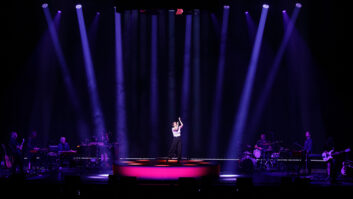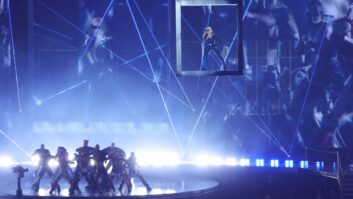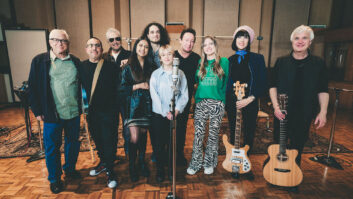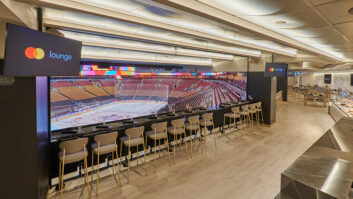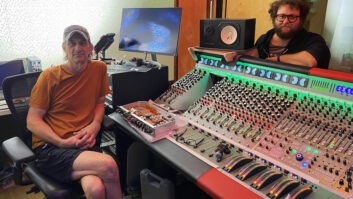The Cavaliers Drum & Bugle Corps, based in Rosemont, IL, use ambitious wireless miking schemes to support marimbas, euphoniums and other unusual instruments. ROSEMONT, IL—Drums and bugle corps competitions date back many decades, yet are in a constant state of evolution. Drum Corps International (DCI), the non-profit governing body, legislated the introduction of microphones and amplification in 2004, followed by electronic instruments in 2009. As a result, now embracing new technologies in drum corps competition is The Cavaliers Drum & Bugle Corps, based in Rosemont, IL.

“As an organization, we have been deliberately progressive in exploring creative ideas when it comes to wireless mics and sound reinforcement,” says Chris Lugo, director of Development and Communications for The Cavaliers. “Microphones help create a balanced sound in our front ensemble, or pit orchestra, and wireless mics allow us to bring new instruments onto the field and to highlight our soloists.”
Tom McGillen is a consulting audio specialist for The Cavaliers, helping design systems for their DCI competitions. “From the time we begin pushing onto the field to the start of performance, we have only about two-and-a-half minutes to set up. There is no soundcheck. A winning program will feature full, rich, and balanced sound across all instruments, so microphone selection and positioning is critically important.”
On the wireless side of things, The Cavaliers opted to use 10 systems in their 2014 program, employing most of them on rolling concert marimbas, with two Shure ULX-P bodypack systems with WM98H/C miniature microphones used to cover the 4.5-octave keyboards. Another WM98H/C system was used on the upward-facing bell of the concert euphonium, bringing that instrument’s unique tone into the mix and allowing it to contribute as a soloist. Reception was enhanced by the use of three Shure UA844SWB antenna systems and two UA874 active directional antennas to cover the football field. The wireless receivers and antenna systems were housed in same sound cart as the mixing console, amplification and outboard electronics.
With so much on the line, most drums corps use just one or two wireless systems. By using 10 systems, The Cavaliers placed themselves at risk, but one they felt was justified by the unique performance capabilities it enabled.
“One of the goals in our design this year was to put some of the best musicians from the front ensemble in the spotlight on the field—a non-traditional location for keyboard instruments,” said McGillen. “This meant we needed wireless systems and microphones that would handle the rigors of a DCI tour and give us great sounding results every performance. We knew that the line of products that Shure has to offer would be a perfect fit.”
At the DCI World Championships, held August 6-9 at Lucas Oil Stadium in Indianapolis, the event organizers helped coordinate wireless frequencies for all participating drum corps, helping ensure open frequencies for performers, crews and media. This was not the norm during The Cavaliers’ summer-long performance tour, where the band’s touring sound engineer, Cristian Good, found workable frequencies using the scanning function on the various ULX-P systems in tow.
Miking the front ensemble orchestra required a similar level of preparation. Most instruments utilized the Shure Beta 98H/C miniature microphone, which is the hardwired version of the mic used wirelessly on the marching marimbas and euphonium; both versions can attach to a drum, the bell of a horn or a mallet instrument. In the front ensemble, the Beta 98AMP was found in several places on the drum kit, including all three toms and both the top and bottom of the snare drum. The kick drum was miked with a Beta 52A dynamic mic, with a Shure PG81 condenser picking up the cymbals. The five timpani drums were miked with two strategically placed SM137 condensers.
The Cavaliers also used some ethnic percussion within the pit orchestra. The sound of the djembe was captured by a Beta 98H/C, while a cajon required two mics: one Beta 98H/C, with a Beta 91A boundary microphone mounted inside.
Overall, The Cavaliers’ 2014 program required 38 channels to cover all the microphones, electronic percussion and synthesizers being used. Nonetheless, the vast majority of the group—the marching drums and brass, along with louder stationery instruments like the glockenspiel—received no sound reinforcement at all.
“That’s the tricky bit,” mused Mc-Gillen. “The entire sound design is still keyed to ensure that there is a balance between the winds and percussion. Our goal with all of the electronics and sound reinforcement is that they be seamlessly integrated together into one ensemble sound.”
The Cavaliers’ Lugo sees miking the band as a key element in the creative sound designs that The Cavaliers are known for. “We have gone out on a limb to explore creative ideas when it comes to wireless mics and sound design,” he says. “We like being known as innovators. Being successful with that approach requires the best equipment, and Shure microphones and wireless systems help us succeed under the most challenging performance conditions.” The Cavaliers purchase their Shure gear from McCormick’s Enterprises, a supplier to the drum corps and marching band market for over 40 years.
Shure Inc.
shure.com
The Cavaliers
cavaliers.org


